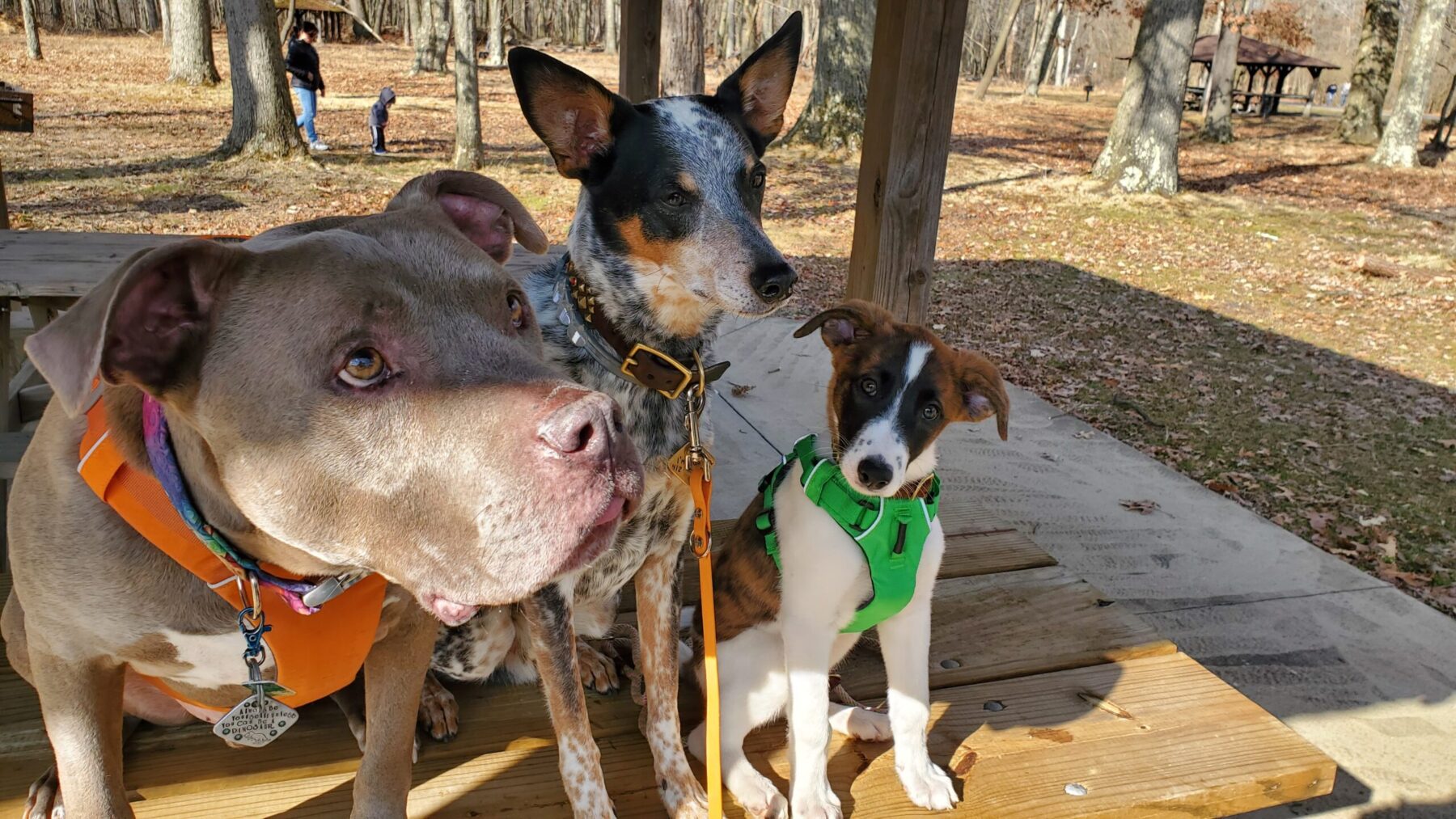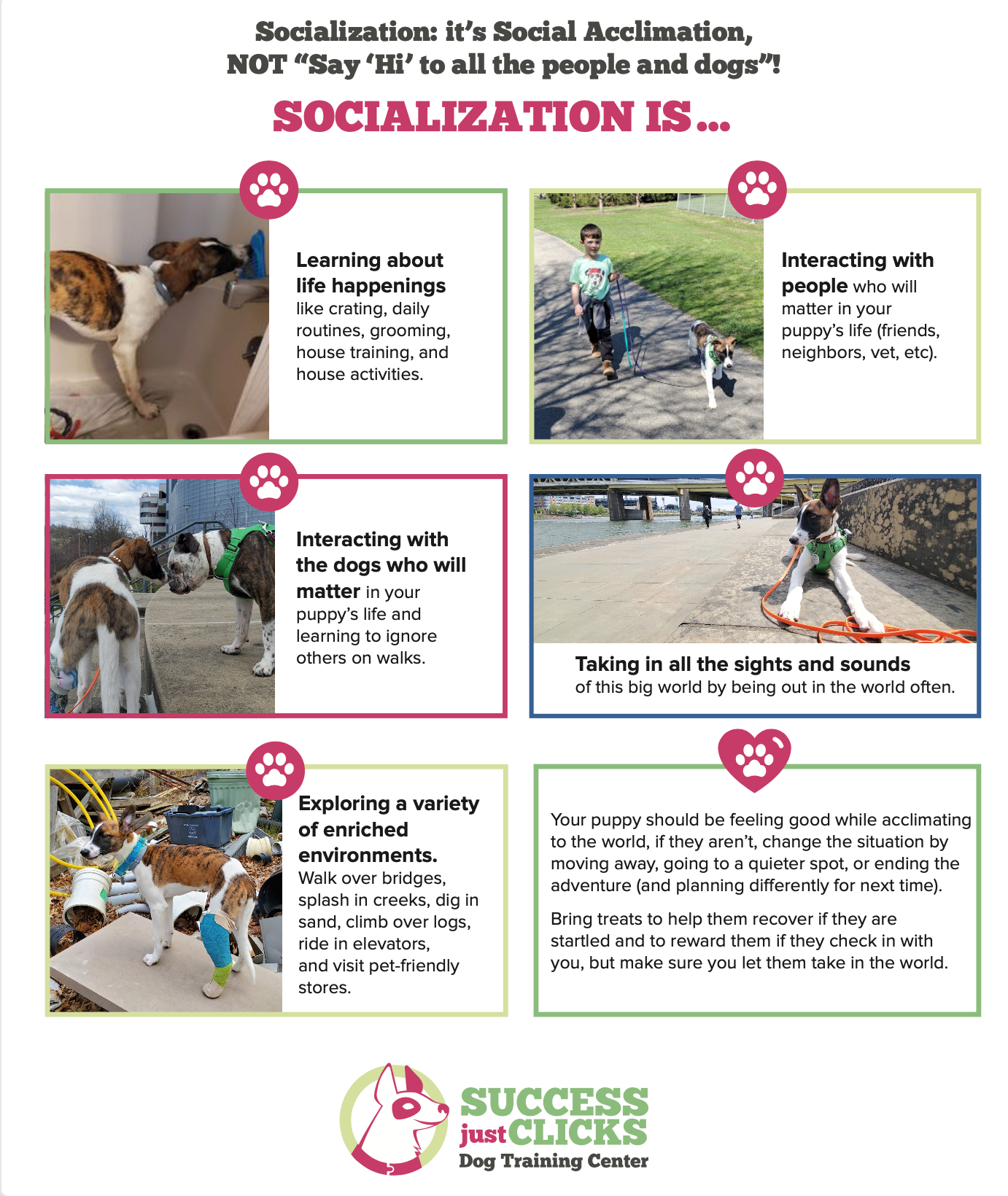
Or not. This is probably the biggest mistake people make under the guise of “socializing” their puppy. Socialization is about acclimating to the world, not going to say hi to everyone and everything in it. On the flip side, socialization, in my opinion, is not about teaching a puppy to focus on you through all distractions and not engage with their world (which is the opposite pendulum swing that I’m starting to see coming from some trainers).
While I appreciate that the concept of socializing has made its way into the pet-parent’s bank of common knowledge and more people are aware it’s a thing they should be doing, I think pet parents are less clear on what socialization is and are not necessarily doing their puppy’s any favors. Basically, I think improper socialization can do as much damage as no socialization so education on what is good socialization is important.
Strax came home to me in mid-March 2020—literally days before the start of the 6 week long COVID19 shut down in Pennsylvania and the beginning of the push for serious social distancing and being fairly isolated. Although the world was drastically different than my prior puppies, his socialization experiences really weren’t all that different than any other puppy I’ve raised because it’s never been about saying hi to every person or dog they came across while in the world.
For me, socialization has always been about learning about the world they are in and normalizing all the crazy things that happen in it and learning to appropriately interact with the friends (human and dogs) who will be a part of their life. They learn that even weird, strange, noisy, unpredictable, and abnormal things are probably actually normal, safe, expected, and not concerning—the world IS strange and unpredictable, but that’s normal.
For my socialization I do a lot of people, dog, environment watching and experiencing. My puppy goes to a ton of different places and a ton of different situations (with thoughtful intensity levels for my dog’s abilities) and is encouraged to experience and watch the happenings around them and realize that weird stuff happens and it’s okay, nothing to worry about. That GIANT rubber ducky on the river, no big deal. The motorized wheelchair coming down the sidewalk, that’s cool. The kids playing and screaming at the park, that’s normal. The crazy inflatable balloon man flapping in the breeze, that’s weird but safe (humans are strange, I know). Walking across that metal plate on the ground that makes a noise, a little surprising but also not going to bite you. Sirens, lights, and hoses firing from a firefighting boat, okay that’s not something that you’ll see often but it is also fine. Being left in your crate while I go to the store is less than awesome, but it’s not the end of the world, I’ll be back. The bridge over the creek that moves as we walk across, that’s nothing to worry about. Crashing through the ball pit playing with friends causes crazy noises, slippery surfaces, balls hitting off your body, and your sliding and falling on the way out… and that’s cool, you’re fine keep going.
I use cookies and toys to help puppies as needed but I don’t want them to focus on me/food/toys and not learn to cope with what’s going on around them or learn how to use their body to safely interact with the weird world. I want them checking out the world and then engaging with me for fun stuff when they are ready, then checking out the world, and then engaging with me for fun stuff, and sometimes engaging with the world for the fun stuff. If something makes them nervous I let them walk away and look at it from a bigger distance, or I’ll use some classical counter conditioning to help them realize snack parties happen around weird things so it’s no big deal.
All of that being said, the socialization plan has to take the individual into account. What are they bringing to the table from a genetic standpoint. Strax, for example, was so solid with people from the get go. He came out of the womb ready to be a therapy dog, so I didn’t worry about the lack of people socialization or only seeing people in masks for his first 18 months of life. He met a couple handful of friends and did a few visits to stores (once the world opened up a bit) but other than that just saw folks at a distance out on walks or adventures. Oswin, came to me significantly more aloof to suspicious with people and had she come home in the middle of a pandemic, I would have needed a completely different socialization plan to prevent her from becoming reactive or overly fearful. Because I knew she had the potential to be concerned with humans, I worked a ton on that side of socialization and she never developed reactivity or aggression issues with people. She’s now really quite neutral and aloof around people, which is quite lovely in a lot of ways. She’s not afraid, just mostly disinterested, she can be around a ton of people and is fine in busy environments because of the early socialization emphasis knowing her predisposition to be suspicious.
So here are my three tips for quality socialization:
1. Socialization should always be in situations where, at the end of the day the puppy was comfortable and happy. If your puppy is overwhelmed or nervous it’s not going to be beneficial—a puppy who is nervous or overwhelmed may be hypervigilant, hyper aroused, incapable of eating super yummy snacks you try to feed them, slinking around, slow to move, bitey or mouthy, or easily startled. If they are nervous at first but you gradually ease them into the environment and they then get comfy and ultimately have fun, that’s fine, but they should acclimate within a couple minutes and they should never be panicked or totally fearful.
2. Puppies should directly interact with the people, dogs, animals who will be part of their life and who will make those interactions positive for the puppy. My general rule is that if we are on a walk, my puppies don’t get to say hi to random strangers they come across (people or dogs–occasionally I’ll let them greet a specific person on a walk for a specific reason, but it’s rare). They get to greet your neighbors (or their dogs) outside in their yard, your friends at their house, your co-workers who drop by to visit, your vet, your sister’s kids at the park down the street, safe dog friends while on hikes, they are getting plenty of good interactions with people and dogs to build positive associations without teaching them to get over excited about random strangers or dogs on walks. Through these thoughtful interactions they are building up their experiences and skillset to be comfortable and engaged with the right people and dogs and learn to be comfortable but neutral about others.
3. Socialization with noises, new places, things, situations, flooring, normal life happenings (like grooming and alone time), and watching activities, should make up the bulk of your socialization work. It doesn’t matter how much your puppy loves people, if they are too scared to leave their house it won’t matter. They need to be comfortable with the neighborhood sights, sounds, and sensations to be able to enjoy being social with folks. Let them engage with the world, take it in, normalize it, and realize that even when where things happen, that is normal so no need to get worried.

